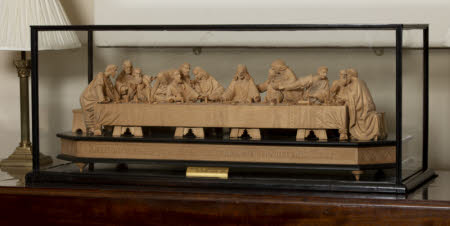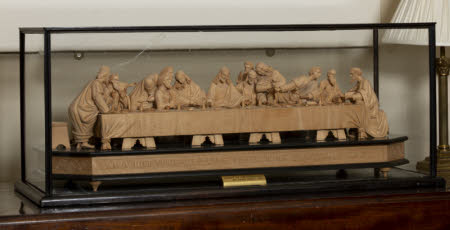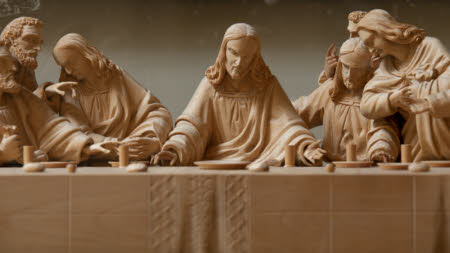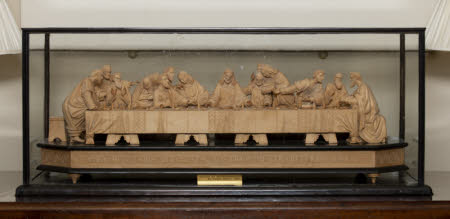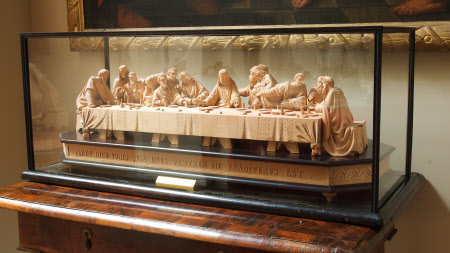The Last Supper
Hans Mayr (fl.1870)
Category
Art / Sculpture
Date
1870
Materials
Limewood
Measurements
260 mm (H); 875 mm (W); 310 mm (D)
Place of origin
Oberammergau
Order this imageCollection
Kingston Lacy Estate, Dorset
NT 1254554.1
Summary
Sculpture, limewood; the Last Supper; Hans Mayr (fl. c. 1870), after Leonardo da Vinci (1452-1519); 1870. A limewood sculpture representing the Last Supper of Jesus Christ and his Disciples, held on the evening before his Crucifixion and death. The sculpture is copied from Leonardo da Vinci’s celebrated fresco depiction of this scene in the refectory of the convent of Santa Maria delle Grazie in Milan, the scene transposed into three dimensions by the sculptor Hans Mayr, who lived in the Bavarian village of Oberammergau, famous for its staging every ten years of Passion Plays, dramatic tableaux relating the story of Christ’s Passion. Mayr was one of many villagers in Oberammergau who made much of their living from the plays, through lodging visitors and making wooden artefacts for sale to the growing numbers of people who came to watch the performances.
Full description
A limewood sculpture, based on Leonardo da Vinci’s fresco painting of the Last Supper, painted for the convent of Santa Maria delle Grazie in Milan between 1495-98. The sculpture reproduces the figurative elements of Leonardo’s painting in three-dimensional form, with Christ depicted seated at the centre of a long trestle table, supported on four double-legs and covered with a single patterned table-cloth. On each side of Christ are seated or standing six of his twelve Disciples, who gesture animatedly, several towards Christ, who has just announced that one among their number would betray him. Leonardo’s original painting places great emphasis on the reactions of the various disciples, including his eventual betrayer Judas Iscariot, who is seated two places to Christ’s right and, significantly, knocks over his drinking beaker with his elbow. This episode is copied for the sculpture, in which the table is set with a variety of plates, some of them with food, and drinking cups. Christ and the Disciples are seated on rectangular stools. The tableau is set on a base consisting of two long octagonal ebonised wood sections, between which is a limewood frieze, partly patterned, and with at the front the inscription AMEN DICO VOBIS QUIA UNUS VESTRUM TRADITURUS EST ('And as they did eat, he said, Verily I say unto you, that one of you shall betray me’, from the Gospel of Saint Matthew, 26.21). The whole ensembled is housed within a glass case, on the floor of which is a label inscribed ‘CARVED AT OBERAMMERGAU. / BY HANS MAYR. 1870’. The sculpture does not appear to be otherwise signed or dated. This large carving is an impressive example of carving from the Bavarian village of Oberammergau, famous for its Passion Plays that depict in dramatic form the story of the Passion of Christ, his final days on earth, death and Resurrection. The plays originated during the Thirty Years War (1618-48), which devasted the German-speaking lands, bringing not just destruction through conflict but also diseases and starvation. In the 1630s Oberammergau, which was situated on the main road between Augsburg and Venice so had many people passing through it, was visited by the plague. The village’s inhabitants resolved to make a collective vow that, were the community to be spared further deaths from the plague, it would every ten years re-enact the story of Christ’s Passion, with the actors drawn from the village’s inhabitants. This vow has been faithfully kept over the centuries, the most recent (42nd) Passion Plays taking place in May-October 2022, having been postponed from 2020, because of Covid pandemic restrictions. Whilst for a long time most visitors to the plays were from the German-speaking world, from around the middle of the nineteenth century Oberammergau began to attract fashionable visitors from all over Europe and America. By the 1870s and 1880s the number of visitors from Britain and, increasingly, America began to be commented on critically by German observers. Thus one Ferdinand Gross wrote in 1880 of the ‘English invasion’, his description focusing on the new innovation of package tours offered by firms such as Thomas Cook: ‘they were all travelling to Oberammergau, every one of them with that quiet satisfaction that only a good conscience and a British travel bureau can give you; they had their tickets, providing them with the certainty that they would find everything ready for them, transport, food, lodgings and seats for the Passion Plays. I do believe that the English are busy arranging their tickets for the Last Judgment and, when the time comes, will smile at we impractical Continentals still making our journeys under our own steam!’ (‘und sie fuhren alle nach Oberammergau, sie Alle mit jener Gemüthsruhe, die ein gutes Gewissen und ein britisches Reisebureau einem einflößen kann; sie hatten ihre Tickets, auf Grund deren sie sicher waren, zum Passionsspiele Wagen, Wohnung, Verpflegung und Billets zu finden. Ich glaube, die Engländer lösen sich Tickets für den jüngsten Tag und einmal werden sie lächeln über uns unpraktische Continentalen mit unserem Reisen auf eigene Faust!‘ Ferdinand Gross, Oberammergauer Passionsbriefe, Leipzig 1880, p.8). At least one member of the Bankes family presumably attended the Oberammergau Passion Plays in 1870, when other British visitors included the Crown Prince Albert Edward (the future King Edward VII) and the banker Leopold de Rothschild. The 1870 production, performed in the village’s small theatre, consisted of a long series of dramatized tableaux, played over some eight hours. A correspondent for the Times who reported on these performances claimed to have never ‘seen so affecting a spectacle, or one more calculated to draw out the best and purest feelings of the heart.’ (The Times, 23 June 1870, p. 10). The description of the key tableau featuring the Last Supper confirms that the performance, like the Kingston Lacy carving, was based on Leonardo da Vinci’s celebrated scene: ‘Our Lord and His disciples appear in a sitting attitude, evidently after the picture of Leonardo da Vinci, but Christ does not pass on the consecrated elements after the manner of the Presbyterian Sacrament. He goes round the group and administers personally to each, after which He girds Himself with a towel and washes the disciples’ feet. And then the chorus, out of sight, sing a solemn hymn; and, immediately after, Christ gives the benediction, and as the curtain is falling you see the disciples following their Master to the Garden of Gethsemane.’ Henry Blackburn, in his even more comprehensive description of the 1870 plays, wrote that ‘The celebration of the Passover [….] is copied from the celebrated fresco by Leonardo da Vinci, and was one of the most solemn and remarkable scenes in the play.’ (Blackburn 1870, p. 97). Numerous members of the Mayr family were involved over many generations in the Oberammergau Passion Plays. In 1870, the unquestioned star of the performances was Joseph Mayr, whose heartfelt portrayal of the part of Christ earned him international attention and the popular name ‘Christus Mayr’ (for Mayr, see Diemer 1900, pp. 177-84). He first played the part of Christ in 1870 when, in fact, most performances had to be postponed to the following year, after Joseph Mayr was among the men from the village suddenly sent to fight in the 1870 Franco-Prussian war. Blackburn wrote of how ‘the acting of Joseph Mair, as the ‘Christus’, was admirable for its quiet tone, and its extraordinary dignity and grace’, whilst for Hermine Diemer ‘My remembrance of Mayr’s ‘Christ’ is uneradicable […] I have never seen a man act with so much soul and feeling, with so little sentimentalism as Mayr.’ (Diemer 1900, p. 179). Whilst it would be exaggerated to suggest that Hans Mayr’s 'Last Supper' was intended to portray Christus Mayr and the other villagers who took part in the tableau featuring this crucial scene from the Passion story, his sculpture is a powerful reminder of the impact that this scene would have had on its audiences, many of whom may not have regarded themselves as especially religious: ‘There was one figure that was sitting near us during the day [….], a well-known face and a well-known name in London society, whose customary place at that hour in the afternoon was the bow window of a west-end club, who was literally ‘bathed in tears’’ (Blackburn 1870, p. 143). No doubt some relative of Joseph Mayr, Hans Mayr was one of many villagers in Oberammergau who tried to make a living from the production of carvings, intended for sale mainly to visitors to the Passion Plays but also sold in centres such as Munich. Despite the growing influx of wealthy visitors to Oberammergau, especially for the performances every ten years of the Passion Plays, life was extremely hard, with many of the numerous woodcarvers struggling to survive. Another member of the Mayr dynasty, Andreas, who also took part in performances later in the nineteenth century, was typical, being described as living ‘in great poverty, barely supporting himself and his numerous family as a wood-turner’ and dying early of consumption (Diemer 1900, pp. 166-67). We know nothing about the life of Hans Mayr, but the Kingston Lacy Last Supper is an exceptionally ambitious work and well beyon the sorts of trinkets that were produced by many of the Oberammergau carvers. The only other sculpture by him currently known is even more impressive, an enormous wooden Crucifix some 6 metres high, in the cemetery of the castle in Lichtenwalde, in Saxony in eastern Germany. Jeremy Warren June 2023
Provenance
Bequeathed by (Henry John) Ralph Bankes (1902-1981), together with the estates of Corfe Castle and Kingston Lacy and its entire contents
Credit line
Kingston Lacy, The Bankes Collection (National Trust)
Marks and inscriptions
Along front of base:: AMEN DICO VOBIS QUIA UNUS VESTRUM TRADITURUS EST ('And as they did eat, he said, Verily I say unto you, that one of you shall betray me’).
Makers and roles
Hans Mayr (fl.1870), woodcarver after Leonardo da Vinci (Vinci 1452 - Amboise 1519), artist
References
Blackburn 1870: Henry Blackburn, Art in the Mountains. The Story of the Passion Play, London 1870 Diemer 1900: Hermine Diemer, Oberammergau and its Passion Play, Munich and Oberammergau 1900
